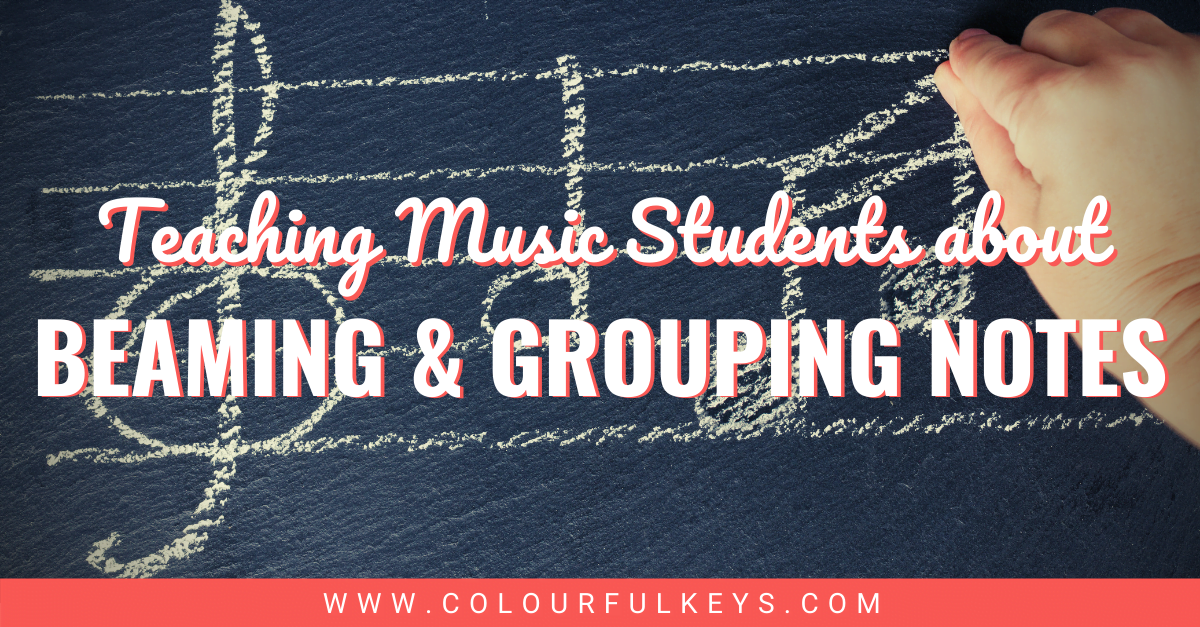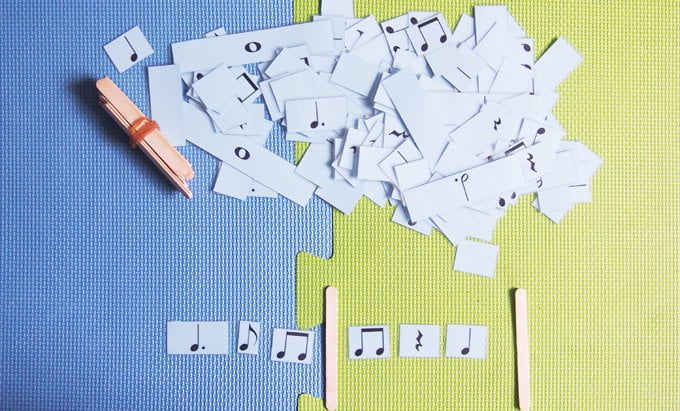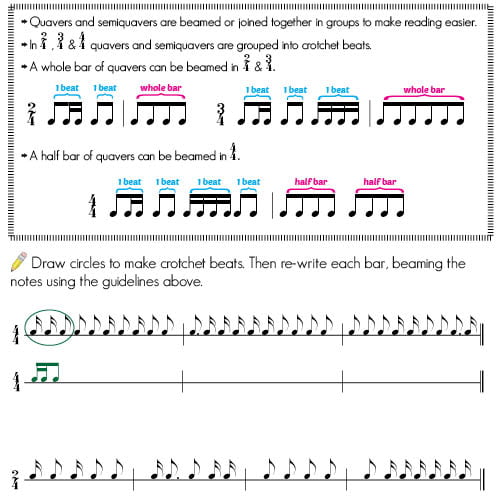Teaching music students about beaming and grouping notes and rests is one of those things in music theory which takes a lot of practice. Plain and simple.

When it comes to groups and beams, there are so many rules to follow and it can seem like none of them make any sense.
But the rules about groups and beams aren’t arbitrary at all. In fact:
- If rests and notes aren’t properly grouped and beamed, music can be very confusing to read.
- Understanding the rules for grouping notes and rests makes rhythmic analysis much easier.
Early intermediate music students need to get to grips with this grouping system so they can compose rhythms and notate music correctly.
This takes practice.
A lot of practice.
That practice doesn’t have to be dry, though. For the skills to really stick, we need lots of different ways for students to learn about and practice beaming and grouping notes and rests.
Here are just a few of the different ways I approach teaching grouping and beaming with my piano students.
The content in this article was first published in June 2017, then edited and expanded in June 2021. For more of the latest-and-greatest in the world of teaching music notation, check out my Music Theory hub page.
Teach Grouping and Beaming with Videos
In these videos, I walk students quickly and simply through the rules for grouping or beaming notes. Use the videos in lessons, send them to parents for their kids to watch or assign them to students as part of lab time.
The videos are designed to be clear and concise so that students can watch them and then get on with some writing work for reinforcement, saving you time to do fun activities during the lesson time.
Videos with International/UK Terms
How to Group Semibreve, Minim, Crotchet and Quaver Rests
How to Group and Beam Quavers and Semiquavers
Videos with USA Terms
The same Thinking Theory videos are also available for audiences using the USA terminology.
How to Group Whole, Half, Quarter and Eighth Rests
How to Group and Beam Eighth and Sixteenth Notes
Teach Grouping with Relative Rhythm Cards
One of my favourite ways to review the rest and note grouping rules is using my relative rhythm cards (I’ve blogged about these rhythm cards before here).
After my students have watched the flipped Thinking Theory videos (above) at home, we get lots of practice in lessons using these note value cards.

The beauty of these cards is that you can mix and match and move them around, which makes it easier for students to see the relationships and rules for grouping rests and notes.
Teach Note Grouping and Beaming with Worksheets
Worksheets still have their place in music lessons, especially for topics as confusing as grouping and beaming.
This page from my Thinking Theory series of workbooks corresponds to the videos above. It introduces the beaming rules with clear illustrations and gives students some hands-on practice.
If you’re a member of Vibrant Music Teaching, you can instantly download the grouping/beaming notes worksheet from the VMT Library.

Subscribe to updates and get the note grouping worksheet.
Enter your details to subscribe to the newsletter for piano teachers with information, tips and offers.
I hate spam as much as you do! I’ll only send you information that’s directly relevant to music teachers and you can unsubscribe at any time.
This worksheet comes from Thinking Theory Book Two page 29. View the full Thinking Theory series here and see what makes these workbooks so special.
Teach Grouping and Beaming with Games
If you’ve followed my blog for very long, you know I’m all about learning through games games games. Teaching grouping and beaming is no different.
Beam Bear and its more advanced counterpart, Beam Bison, are just 2 of the many resources inside the Vibrant Music Teaching Library which can be used to practise applying the grouping and beaming rules.
Not a member of Vibrant Music Teaching yet? These 2 games are just the tippy top of a very gigantic iceberg. Look at all you’re missing out on!
Teach Grouping and Beaming Through Composing
If you struggle to get your students to do their theory work, then composition could be the answer.
One of the many benefits of having your students to write their own music is the incognito theory they’ll get in the process.
When students have to write their own creations down, they’ll have to use their knowledge of grouping and beaming in order to properly notate the music. Their own compositions become note beaming exercises in disguise.
How do you teach music students to beam and group notes and rests?
Share your ideas in the comments below so we can continue expanding this list of ideas.


